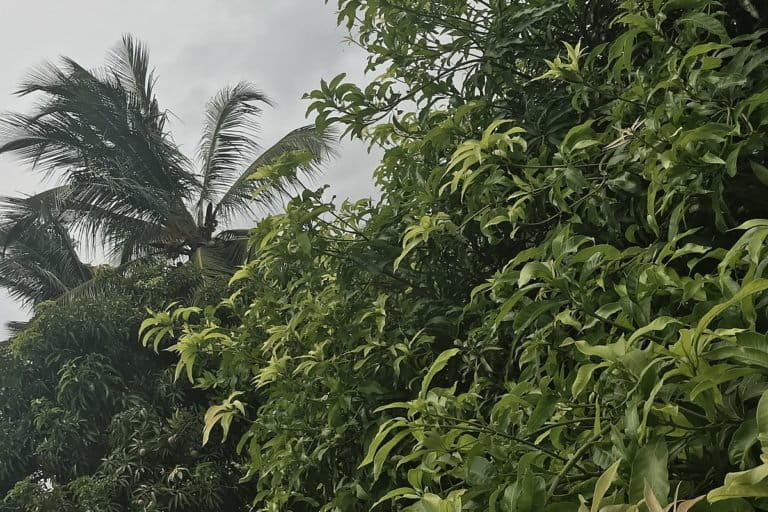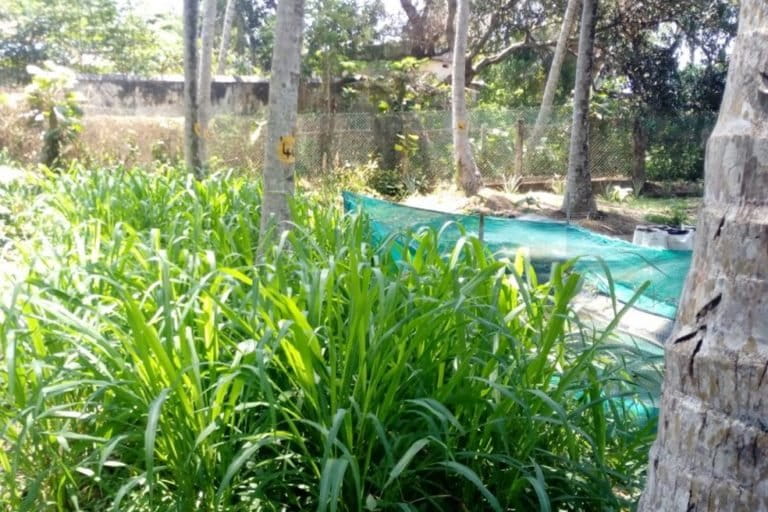- Coconut-based integrated farming offers scope for improving crop biodiversity and farm productivity, finds a study.
- The system involves growing coconut as the major crop coconut, with intercrops, such as vegetable, fruit, spices, fodder and tuber crops.
- It could also emerge as a means to sequester carbon and reduce fertilizer consumption while helping farmers increase their income.
Coconut-based integrated farming, which allows for other agricultural crops to grow under the canopy, not only offers scope for improving crop biodiversity and farm productivity, but also a means to sequester carbon, according to a new study that cites Kerala as an example.
A coconut-based farming system (CBFS) involves growing many shade-thriving or ‘sciophytic’ agricultural crops in coconut plantations. The system has a two-fold benefit: it ensures economic benefits by improving crop productivity, and it can serve as an example of a nature-based solution (NbS), finds the study. It was conducted by a team led by Jacob John, a professor at the Kerala Agricultural University.
The International Union for Conservation of Nature (IUCN) defines nature-based solutions as “actions to protect, sustainably manage, and restore natural and modified ecosystems that address societal challenges effectively and adaptively, simultaneously providing human well-being and biodiversity benefits.”
John’s team developed a coconut-based integrated farming system (IFS) model suited for lowlands, at the Integrated Farming System Research Station (IFSRS), Karamana under Kerala Agricultural University. Based on their previous estimates, the model uses an area of 0.2 hectares (ha), which matches the average per capita land availability of the marginal farmer in the state.

Increased crop biodiversity and farm income
Apart from the major crop coconut, the model includes intercrops such as vegetable, fruit, spices, fodder and tuber crops. It also incorporates allied enterprises such as livestock; farming of azolla, an aquatic fern that lives symbiotically with a blue-green algae and is a good bio-fertiliser; and agroforestry. Tree species added to the model include teak, jackfruit, breadfruit, garcinia and mango.
Data collected over five years for this research showed that the productivity under the IFS model was enhanced tenfold compared to that under the sole crop of coconut for the same area, the team wrote in an article published in the Journal of Plantation Crops, highlighting their research.
The model generated food products in excess; more than the requirement of a four-member family, and the surplus production could contribute to a farmer’s income, while also generating considerable employment. The IFS model can also generate plant nutrients within the farm through organic recycling.

“Coconut, when grown as a monoculture, often leads farmers to distress mainly due to crop loss associated with the pest and disease incidences and market price fluctuations,” John told Mongabay-India.
Coconut-based integrated farming can enhance the yield from the unit area and bring about a considerable hike in farm income, apart from environment-friendly effects resulting from saving fertilisers, he says. The social relevance of such systems also is quite promising, as evidenced by the generation of more employment opportunities, as detailed in the study.
Further, it is a ‘climate-smart’ solution as it reduces the use of chemical fertilisers, through the generation of plant nutrients from crop residues, and dung and urine obtained from livestock, the report says. On an average, plant nutrients to the tune of 177 kilograms (kg) nitrogen, 89 kg phosphorus and 98 kg potassium were generated annually from the model.

The model also results in net negative emissions of greenhouse gases, mostly through agroforestry. The inclusion of tree components like teak, mango, jackfruit, garcinia, rose apple, and breadfruit, along with the main crop coconut contributes to the build-up of above and below-ground plant biomass, which can sequester carbon. The agroforestry component contributes over 90 percent carbon sequestration, the researchers detailed.
Coconut farming is one of the most natural agricultural systems, says Rajeswari Raina, a specialist in agricultural economics and Professor at the Department of International Relations and Governance Studies at Shiv Nadar University near Delhi. In India, the traditional practice of burying coconut husks in the soil helps in soil water retention, and by thus preventing soil water run-off, helps in groundwater recharge, she points out.
“Further, the conversion of small farmer holdings into profit-making ones through the intensive use of land through diversification of crops, involving an integrated farming system with several crop combinations, helps generate additional income,” Raina explains. Such systems spread out risks due to climate vagaries and pest attacks, as farmers do not have to depend on income from a single crop.
A separate study by Odisha University of Agriculture & Technology (OUAT) based in Bhubaneswar, showed that coconut-based agroforestry systems play an important role in terms of improving productivity, soil quality and providing food, fodder and fuel wood.
Apart from pure coconut plantations, many farmers are engaging in combining different crop combinations along with coconut. CBFS offers wide spacing and higher incidence of light under the canopy, while the limited effective root zone of the coconuts allows other crops to grow well within the grove.

The pressures of a growing population, lesser land to cultivate and worsening conditions of farmlands are triggering an interest in farming systems that optimise the use of the limited land resources, and as a result, an interest in intercropping.
The study found that coconut-based agroforestry systems, particularly up to 1.2 acres (0.49 hectares) in size, provide not only financial benefits, but also other benefits such as food, fuel, timber, fodder, thatching, shade, a good microclimate and a habitat for birds.
A project by the Indian Council of Agricultural Research – Central Institute of Women in Agriculture (ICAR-CIWA) attempted to standardise suitable intercrops in coconut-based multi-storey cropping model with banana, papaya and guava as second storey crops, in order to improve the productivity and utilization of land, energy and water resources, as well as income of farm women. Different ground storey intercrops such as cowpea, turmeric, elephant foot yam and pineapple were grown in the interspaces of the main crop.
“This system enables a steady supply of farm products the whole year round,” the project found. “This system will give income 4-5 times more as compared to traditional system,” the project report added.
Coconut-based farms as climate smart agriculture
The Philippines, Indonesia and India are the three largest producers of coconut, one of the earliest domesticated plants. In India, over 21.7 lakh (2.17 million) hectares were under coconut cultivation in 2020.
A recent paper in the journal Nature Based Solutions found that CBFS offers some key benefits. The system provides innumerable opportunities for integrating diverse forms of crops in the same land management system, including food crops, fruit trees, roots and tubers, permanent plantation crops, medicinal plants and multipurpose trees. Such integrated farming systems are generally more productive than the single-crop plantation systems, and contribute to improved food security, environment management along with economic returns.
Secondly, the coconut palm is very resilient as it can withstand natural calamities like cyclones and flooding, which makes it useful for combatting increased cyclones, floods and droughts unleashed by a changing climate.
CBFS also offers scope for enhanced carbon capture and storage in soil-crop systems, which has the potential to minimise CO2 emissions. This includes carbon sequestration in soil and biomass, as well as the substitution of fossil fuels with biodiesel made from biomass or coconut oil. Such systems can serve as carbon pools or sinks that absorb carbon.
The report in Nature Based Solutions cites a study from Sri Lanka which estimates that the ecosystem (plant and soil) carbon stock of CBFS in Sri Lanka ranged from 32 megagrams (Mg) to 72 Mg (1 megagram = 1,000 kilograms) of carbon per hectare, while the net carbon balance ranged from 0.4 Mg to 1.9 Mg of carbon per hectare per month under various growth conditions.
Raina, however, points out that it is erroneous to assume that they will all lead to net negative emissions in of greenhouse gases. Net emissions will be negative only if no chemical fertilisers are used on the farm, and the farms use totally on-farm or local organic inputs, she says.
Another study on climate-smart villages in the Philippines by the CGIAR showed how growing intercrops such as coffee, black pepper, banana, cacao and other trees were grown on coconut farms could raise incomes considerably by 2025. The study was based on 29 households that were interviewed in the Himbubulo Weste and Magsaysay villages in the Philippines in 2020, where almost half of the income earners depended on coconut farming for their livelihoods. The study showed that the community as a whole would have the opportunity to increase their cash position when the climate smart agriculture interventions such as intercropping and backyard livestock growing are in use.
Taking Himbubulo Weste and Magsaysay together, the net income increased by $29,309 (PhP 1.73 million), when revenues and expenses in swine production and fruit trees and black pepper farming were added,” the analysis shows.
Read more: [Commentary] A just growth pathway for agriculture in a changing climate
Banner image: Coconut-based farming systems also offer scope for enhanced carbon capture and storage in soil-crop systems, which has the potential to minimise CO2 emissions. This includes carbon sequestration in soil and biomass. Photo by Jacob John.
